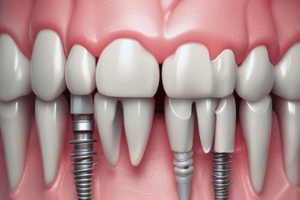Podcast
Questions and Answers
According to the text, what is the thickness of the epithelium?
According to the text, what is the thickness of the epithelium?
- 3 millimeters
- 1-2 millimeters
- 0.8 millimeters
- 0.3-0.4 millimeters (correct)
What type of graft is shown in the histology done by Peter Schipbach?
What type of graft is shown in the histology done by Peter Schipbach?
- Soft tissue graft
- Laminar graft
- Epithelial graft
- Connective tissue graft (correct)
Who specifically conducted the study mentioned in the text?
Who specifically conducted the study mentioned in the text?
- Lateral palette
- Peter Schipbach
- Peter Schipbach and Joe
- Joe and co-worker (correct)
What is the standardized thickness of the laminar property?
What is the standardized thickness of the laminar property?
What is the purpose of dipitalizing the area in the video?
What is the purpose of dipitalizing the area in the video?
Which expert has over 30 years of experience in implant dentistry?
Which expert has over 30 years of experience in implant dentistry?
Soft tissue grafting is used to gain volume in which zone of dental implants?
Soft tissue grafting is used to gain volume in which zone of dental implants?
When is soft tissue grafting often done?
When is soft tissue grafting often done?
What is the recommended healing time for soft tissue grafts?
What is the recommended healing time for soft tissue grafts?
Which grafting technique is commonly used when the tuberosity graft is not sufficient in volume?
Which grafting technique is commonly used when the tuberosity graft is not sufficient in volume?
Study Notes
Soft Tissue Grafting in Implant Dentistry
-
Ulrich Grunder is a leading expert in implant dentistry with over 30 years of experience.
-
Soft tissue grafting is used to gain volume in the aesthetic zone of dental implants.
-
Soft tissue grafting is often done in conjunction with bone augmentation for better results.
-
Soft tissue grafting is necessary to compensate for the thinning of soft tissue after tooth extraction.
-
Immediate implant cases always require soft tissue grafting to maintain stability and aesthetics.
-
Soft tissue grafting is also used to remove scar tissue and improve the overall appearance of the implant site.
-
Timing of soft tissue grafting varies depending on the case, but it is often done at the time of tooth extraction or implant placement.
-
Soft tissue grafts are left to heal for about 6-8 weeks before proceeding with further procedures.
-
The removal of scar tissue is done as the first step in the soft tissue grafting process.
-
Soft tissue grafting is done using a non-resorbable membrane, which allows for better bone growth.
-
The flap is closed after soft tissue grafting and allowed to heal for 4 weeks before the second stage procedure.
-
Soft tissue grafting is a crucial step in achieving stable and aesthetically pleasing implant results.Soft Tissue Grafting for Late Failures in Implants
-
Soft tissue grafting is important for both immediate and delayed implant placement.
-
Late failures in implants can occur even 19 years after the initial procedure.
-
Soft tissue grafting is necessary for late failures with thin soft tissue.
-
The Vestibular Incision Subperiosteal Tunnel Access (VISTA) technique is used for thin soft tissue.
-
Soft tissue augmentation is more important than placing any xenograft in the extraction site.
-
Autograft is the gold standard for soft tissue grafting, but xenograft may have benefits in some cases.
-
The tuberosity graft is often not sufficient in volume, so lateral palatal graft is commonly used.
-
The choice of grafting technique does not significantly affect the final result.
-
Connective tissue grafts are preferred, but the deeper we go, the more fat tissue we have.
-
The harvesting technique involves a quick procedure with a horizontal incision.
-
Taking larger grafts ensures better blood supply and reduces shrinkage.
-
The mucoderm technique using the Mucatom instrument allows for precise de-epithelialization in the patient's mouth.
Studying That Suits You
Use AI to generate personalized quizzes and flashcards to suit your learning preferences.
Description
Test your knowledge on soft tissue grafting in implant dentistry with this informative quiz. Learn about the importance of soft tissue grafting, its various techniques, timing, and its role in both immediate and delayed implant placement. Challenge yourself and enhance your understanding of this crucial aspect of achieving stable and aesthetically pleasing implant results.




